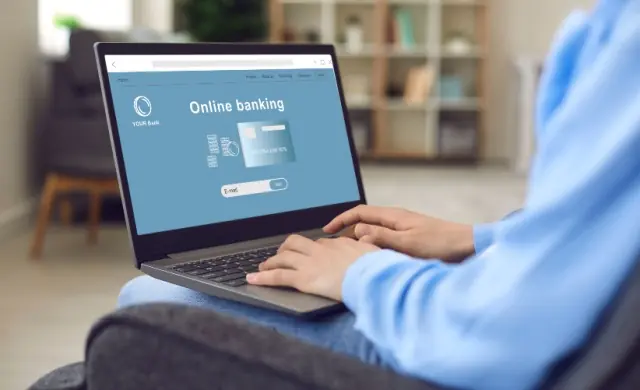In the fast-changing world of digital banking, knowing the latest banking UX trends is key to staying ahead. These trends show the best practices and new ideas in user experience in banking. They help banks offer smooth and engaging digital experiences. Trends cover many areas of financial UX design, from banking app UX to responsive web design. By following these trends, banks can offer the best bank UX, keep customers happy, and stay competitive. We’ll dive deeper into these exciting trends to see how they are transforming digital banking.
Using banking UX trends brings many benefits to financial institutions. For example, using trends like AI-driven personalized recommendations and replacing PDF forms with digital processes can greatly improve user experience in banking. Also, the rise of biometrics and the growth of mobile banking are key parts of modern financial UX design. These innovations, along with no-code development, set new standards for banking app UX and responsive web design. In this article, we will explore these topics in detail. We will share insights into the best practices for banking UX design and how they can revolutionize your digital banking experience.

What is Banking UX?
Banking UX is all about designing user experiences for banking apps and services. It aims to create easy, engaging, and smooth interfaces for customers using digital banking.
Good banking UX is key to keeping customers happy and loyal. It includes easy navigation, personalized experiences, and strong security features. For example, combining banking app UX with responsive web design ensures users have a consistent experience on both mobile apps and desktop sites.
Banks hire UX architects and experienced UI designers from a UX research agency to build effective banking UX. These experts use UX research to understand what users need and how they behave. They gather feedback through interviews, personas, and usability tests. This helps banks create features that are both useful and enjoyable to use.
Following the latest banking UX trends can greatly improve financial services. Trends like AI-driven personalization, biometric security, and the growth of mobile banking are setting new standards in digital banking UX design. These advances make banking easier and safer, improving the overall user experience.
Focusing on banking UX helps banks stay competitive. It provides users with efficient and pleasant ways to manage their money in the digital age.

Benefits of Incorporating Banking UX Trends in Digital Banking UX Design
Incorporating banking UX trends into digital banking UX design offers significant advantages. These benefits enhance both customer satisfaction and the efficiency of financial services. Here are some key points to consider:
Improved Customer Satisfaction
Banking UX trends like AI in UI UX design and personalized services help create more user-friendly experiences. AI can provide tailored financial advice, making interactions more relevant and engaging. This personalized approach leads to higher customer satisfaction and loyalty.
Enhanced Security
Integrating advanced security measures, such as biometric authentication, is a crucial trend in digital banking UX design. These features ensure that users feel safe while conducting transactions. In turn, this builds trust and confidence in the digital banking platform.
Increased Accessibility
Modern banking UX trends focus on making financial services accessible to all users. This includes designing interfaces that are easy to navigate for people of all ages and abilities. By improving accessibility, banks can cater to a wider audience, enhancing their customer base.
Boosted Engagement
Incorporating elements of gamification, as seen in fintech, can significantly boost user engagement. Gamification makes routine banking tasks more enjoyable. Moreover, it encourages users to interact with their banking apps more frequently. This approach leverages the power of financial UX design to create a more engaging and enjoyable user experience.
Streamlined Processes
UX research plays a vital role in understanding user behavior and preferences. By analyzing this data, UX design agencies can create more efficient and intuitive banking interfaces. Streamlined processes reduce the time users spend on tasks, enhancing user satisfaction.
Competitive Advantage
Embracing the potential of UX design in banking can provide a significant competitive advantage. Banks that focus on user experience can differentiate themselves from competitors. It helps them attract and retain more customers. This focus on the impact of design can lead to increased market share and profitability.
In conclusion, incorporating banking UX trends into digital banking UX design not only improves user satisfaction and security but also enhances engagement, accessibility, and efficiency. By focusing on these trends, banks can stay competitive and provide exceptional service to their customers.

7 Incredible Banking UX Trends You Need
Incorporating banking UX trends into digital banking UX design can significantly enhance the user experience and streamline banking operations. Here are some key trends and their benefits:
1. Transitioning from PDF Forms to Digital Workflows
Replacing PDF forms with digital processes simplifies data collection and improves user experience. Digital workflows validate data in real time, reducing errors and back-and-forth communication. This transition ensures a smoother process for users and staff. It enhances satisfaction and reduces administrative burdens.
2. Leveraging Artificial Intelligence for Enhanced User Experience
AI in UI UX design enables personalized and efficient interactions. AI can analyze user behavior. It provides tailored recommendations, streamlines customer service, and predicts user needs. This makes banking more intuitive and engaging. It drives customer satisfaction and loyalty.
3. AI-Powered Personalized Financial Recommendations and Planning
AI-driven tools offer personalized financial advice based on user data. These tools help users make informed financial decisions. This includes budgeting and investment strategies. This personalized approach enhances user experience. It makes financial planning more accessible and effective.
4. Augmenting Your Workforce with Chatbots and Virtual Assistants
Chatbots and virtual assistants provide instant, 24/7 support for banking customers. They can handle routine inquiries, assist with transactions, and offer personalized advice. This improves user experience and frees up human staff. Staff can focus on more complex tasks. This increases efficiency.
5. The Continued Expansion of Mobile Banking
Mobile banking continues to grow as users demand convenient, on-the-go access to financial services. Enhancing mobile banking interfaces with responsive design ensures a seamless experience across devices. This expansion caters to the increasing reliance on smartphones for daily banking activities. It improves user engagement and satisfaction.
6. Increasing Adoption of Biometrics in Mobile Banking
Biometric authentication, such as fingerprint and facial recognition, enhances security in mobile banking. It provides a quick and secure way for users to access their accounts, reducing the risk of fraud. This trend helps build trust and confidence among users, making digital banking safer and more reliable.
7. Enhancing User Experience with No-Code Development
No-code development platforms enable quick and easy creation of digital products without extensive coding. This empowers banks to rapidly prototype and deploy new features, responding swiftly to user needs and market trends. It also allows for greater customization and innovation in banking apps.
Embracing these banking UX trends in digital banking UX design can significantly improve user satisfaction, security, and operational efficiency. By staying ahead with these innovations, banks can offer superior digital experiences that meet the evolving needs of their customers.

Best Practices for Banking UX Design
Implementing effective banking UX design is essential for improving customer satisfaction and operational efficiency. Here are some best practices to follow:
1. Ensure Clear and Intuitive Navigation
Designing a user-friendly navigation structure is crucial. Users should be able to find what they need quickly and easily. Expanding menus and clear links to frequently used pages, like branch locations and online banking login, enhance the user experience. They also encourage deeper site engagement.
2. Focus on Mobile Optimization
A significant part of web traffic comes from mobile devices. Therefore, your digital product must work seamlessly across all platforms. Mobile optimization involves designing for various screen sizes and ensuring features are easily accessible on smartphones. This practice caters to the increasing reliance on mobile banking.
3. Personalize User Experiences
Personalization in banking app UX builds trust and improves efficiency. Allow users to customize their dashboards and receive personalized financial advice based on their spending habits. This level of personalization shows that you value users’ unique needs and preferences. It enhances their overall experience.
4. Integrate Security Features Transparently
Security is a top priority in banking. Communicate security measures like encryption and multi-factor authentication. Use simple language and recognizable icons. This builds user confidence and ensures they understand the protections in place.
5. Utilize Design Thinking
Apply design thinking to develop solutions that address real user needs. This approach uses iterative testing and feedback. It ensures the final product is functional and enjoyable. It helps create a user-centered design that adapts to evolving customer expectations.
6. Provide Accessible and Inclusive Design
Accessibility is key to a successful interface design. Use high-contrast colors, readable fonts, and support for screen readers. Provide alternative text for images and easy-to-navigate forms. This ensures all users, including those with disabilities, can access your services effortlessly.
7. Simplify Content and Functionality
Avoid overwhelming users with too much information. Present content in digestible chunks using cards and clear sections. Simplified content and intuitive design help users find what they need quickly. This enhances their experience with the digital platform.
8. Incorporate Real-Time Data
Providing real-time updates on transactions and account information is essential. Users expect immediate feedback on their actions. Real-time data helps build trust and ensures users feel in control of their finances.
By following these best practices, banks can ensure their banking UX design not only meets but exceeds user expectations, fostering loyalty and satisfaction. These strategies help create a seamless, secure, and engaging digital banking experience.

Best Bank UX Design Examples
In the world of digital banking, banking UX design plays a crucial role in delivering user-friendly and efficient services. Here are some standout examples globally and in India:
Global Examples
Starling Bank
Starling Bank’s app offers a highly personalized experience. Users can display personal finance statistics about their spending, which enhances transparency and control. This level of personalization builds trust and retains customers, showcasing top UX in the banking sector.
Capital One
Capital One’s app incorporates gamification elements to make financial management engaging. Users earn badges for achieving savings goals, adding a playful twist to responsible banking practices. This approach enhances user experience and motivates users to stay on track with their financial aspirations.
Ally Bank
Ally Bank excels in data visualization. Its “Overview” page provides a clear picture of the user’s financial situation, including account balances, upcoming bills, and spending trends. This digital product empowers users to make informed decisions about their money.
Revolut
Revolut’s app design is notable for its colorful, minimalist aesthetic. The app uses shades of pink, blue, and black to differentiate currencies and accounts, making navigation intuitive. Its interface design helps reduce the learning curve for new users, showcasing creative design thinking in banking.
Indian Examples
Kotak Bank’s 811 App
Kotak Bank’s 811 app uses cards to display recent transactions and account summaries. This minimizes clutter and promotes a streamlined banking app UX. Its interface design helps users scan their financial activity easily, reflecting effective UX design to create products that enhance user engagement.
HDFC Bank
HDFC Bank’s mobile app offers customizable notification settings. Users receive alerts relevant to their needs, such as suspicious login attempts or upcoming bill payments. These useful notifications help users manage their finances proactively and ensure a seamless banking experience.
Axis Bank
Axis Bank’s app utilizes biometric authentication, such as fingerprint scanning, for secure and quick access. This feature ensures high security without compromising ease of use. It exemplifies banking innovation when it enters the digital space.
IDFC FIRST Bank
IDFC FIRST Bank’s app employs progressive disclosure, keeping the main screen focused on essential functions like account balances and recent transactions. Additional features are neatly tucked away within menus, maintaining a clean and clutter-free user interface.
Karnataka Bank
Karnataka Bank’s website now offers comprehensive features, including easy access to fund transfers, bill payments, and account management. The website’s design focuses on simplicity and ease of use, making it accessible to all users. Features such as intuitive navigation, responsive design, and secure login methods ensure a seamless user experience. Notably, ScreenRoot recently revamped and launched this new website, ensuring it meets modern standards for usability and functionality. Explore the details of this project at the link.
These examples highlight how top banks use innovative banking UX design to enhance user experience, security, and engagement. By employing the services of a UX design agency, these banks have managed to create intuitive and efficient digital products that cater to modern user needs.

The Impact of Banking UX Trends
Incorporating the latest banking UX trends into digital banking UX design is essential for modern financial institutions. These trends, such as AI-driven personalization, biometric security, and no-code development, greatly enhance user experience, security, and operational efficiency. Banks can offer superior digital experiences that meet evolving customer needs by staying current with these innovations. Following best practices like clear navigation, mobile optimization, and real-time data updates ensures that banks provide a seamless and engaging user experience. Embracing these trends helps financial institutions stay competitive, attract more customers, and improve overall satisfaction.
Contact ScreenRoot for Award-Winning UI UX Services
ScreenRoot, winner of the UI UX Digital Agency of the Year 2024 at the Great Indian BFSI awards, can help your financial institution leverage the latest banking UX trends. Explore our Work and Services pages to learn more about our innovative solutions. Contact us at [email protected], call us at 1800 121 5955 (India), or reach out via WhatsApp. Alternatively, fill out our Contact Form on our website, and a team member will get in touch with you.







